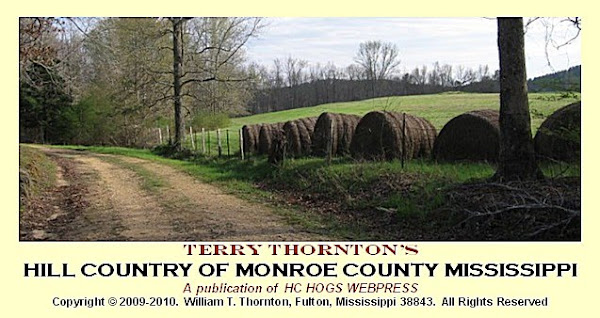Note: Hill Country is a column from the Monroe Journal, Amory, Mississippi. My articles appear there every other week. After the column appears in MOJO it is then published here on the blog. I am happy to be writing in the newspaper of the Hill Country, the Monroe Journal. Below is the column from March 31, 2010.
~~~~~~~~~~~~~~~~~
PARHAM GIN OF EASTERN MONROE COUNTY
by Terry Thornton
About mid-way between Oak Grove and Mt. Zion was once a cotton gin operated by the Parham family. Today the road by the old gin site is known appropriately as "Parham Gin Road" but little evidence of the once busy gin lot and building remains.
Some of the Parham ginners included Ira Coleman "Cole" Parham, his son John Robert Parham, and grandson John Robert Parham Jr.
Cotton gins were once the hub of much activity during the fall harvest season. Often running day and night for weeks, gins frequently had difficulty keeping pace with the cotton harvest. Before the time of mechanical cotton pickers, hundreds of people were employed to pick cotton. Schools even had special schedules during the cotton harvest so that children could pick cotton.
Cotton was the cash crop for almost all small hill country farmers. The way of life of the hills evolved around this crop --- and gins and cotton pickers were necessary for the economy.
Parham Gin was an exciting place to visit. The noise and the motion were hypnotic; the complicated machinery made the gin a dangerous place for an unsupervised child to visit.
When enough cotton for a bale was picked, usually about 1,200 pounds, the load was carried to the gin and signed in. Busy farmers often would leave their wagon-loads of cotton and head back to the fields to pick more. The ginning crew would process the load of cotton in turn (and often late at night) and the farmer would return to pick up the paper-work and his wagon the next day.
The bales of cotton would be sent to the warehouse and the farmer could then sell the cotton whenever he thought the price was "right." Of course the cotton warehouse owners extracted a small amount for brokerage and handling --- but the storage and management of 500+ pound bales of compressed cotton was better handled by the warehouse managers than the farmer.
But what of the gin? The actual ginning process took place in large intricate machines called gin stands. These stands used blowers, cleaners, and gangs of high-speed rotating saws to separate the cotton lint from the seeds. Parham Gin had multiple gin stands and those machines were under the control of the ginner and his assistants.
The ginning process as I remember at Parham Gin in the 1940s was quite standardized. A wagon-load of cotton would be pulled up to the gin porch to be weighed (the empty wagon would be weighed again and the difference was the weight of cotton prior to ginning). A telescoping tube counterweighted to make the work easier would be dropped into the load of cotton and a strong vacuum of air would suck the cotton up and into the gin. The person operating this tube watched for foreign objects in the cotton which might spark and cause the gin to catch fire. Rocks and coins and pieces of metal were major hazards.
Inside the gin, the air would move the cotton to the gin stands; blowers would clean some of the debris from the cotton and the cotton would pass into the rollers and saws. The gin stand would separate the lint from the seed. Seeds and hulls would be moved by air currents outside the gin and the cotton fibers collected and pressed into a bale.
The danger of fire was constant, but the danger of injury from the machines caused even more concern. Watching the cotton pass through a gin stand was a blur of motion and noise. Parham Gin was an exciting but dangerous place to visit.
Experienced gin workers maintained the gin stands which needed constant monitoring to prevent fires and to unclog jams of cotton, lint, or fibers. One mistake and the worker could lose fingers, hands, arms, or even his life.
A member of my wife's Arkansas ginning family, an experienced professional ginner in the vast cotton land of the "delta" region just west of Memphis, was killed trying to unclog a gin stand. He was pulled into the machine and died a horrible death.
Another gin stand accident involved a seven-year-old lad from nearby Fayette County, Alabama. In 1903 he was pulled into the gin stand of the Killingsworth Gin. His uncle grabbed him out but not before the child lost both arms at the shoulders and his uncle lost a hand. Both survived. The boy grew to adulthood and learned to write holding a pen with his mouth. He lived another sixty-five years without arms. His arms and his uncle's fingers are buried in a marked grave at New River Cemetery.
Today when one drives past the lot where Parham Gin once stood there is no evidence that once in cotton ginning season the ground around the gin and the road-side leading to it would be covered with "Mississippi snow" --- cotton. Those "snow" covered roads and fields exist now only in memories.
~~~~~~
Terry Thornton is a retired college administrator and former Amory Middle School principal who resides in Fulton. He can be contacted at hillcountrymonroecounty@gmail.com or at FaceBook.
~~~~~~~~~~~~~~~~~

No comments:
Post a Comment